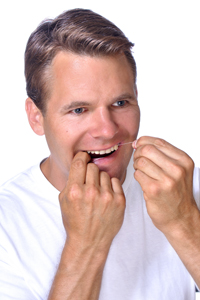 One of the simplest preventive hygiene exercises you can do for yourself is something you’ve heard of before. It bears repeating: floss.
One of the simplest preventive hygiene exercises you can do for yourself is something you’ve heard of before. It bears repeating: floss.
Every 24 hours, bacteria contribute to a new batch of plaque. Brushing, no matter how well or how long, won’t get all the “bugs,” especially between teeth and where your teeth meet gum tissue.
Flossing before or after brushing should be a part of everyone’s home care program. The kind of floss—waxed, unwaxed or tape—doesn’t matter. Just choose what you’re comfortable with and use it.
- Wrap about 18 inches of floss around your fingers. Give yourself an inch or two to work with. If the floss frays or builds up with debris, re-loop the floss and keep at it.
- Start on the upper molars, way in the back; they’re the most difficult to reach. Remember teeth are some-what rounded, so floss up and down rather than back and forth. Follow the curve of enamel on every surface you can, three to four passes each.
- Where teeth meet you may need to use a gentle sawing motion to pull the floss to the gumline. But avoid any sawing at the gumline—it may damage soft tissue.
- Rinse when done, and there you are.
If you feel you’re “all thumbs,” try using a floss threader. We’ll show you how to handle one. Just ask us.

